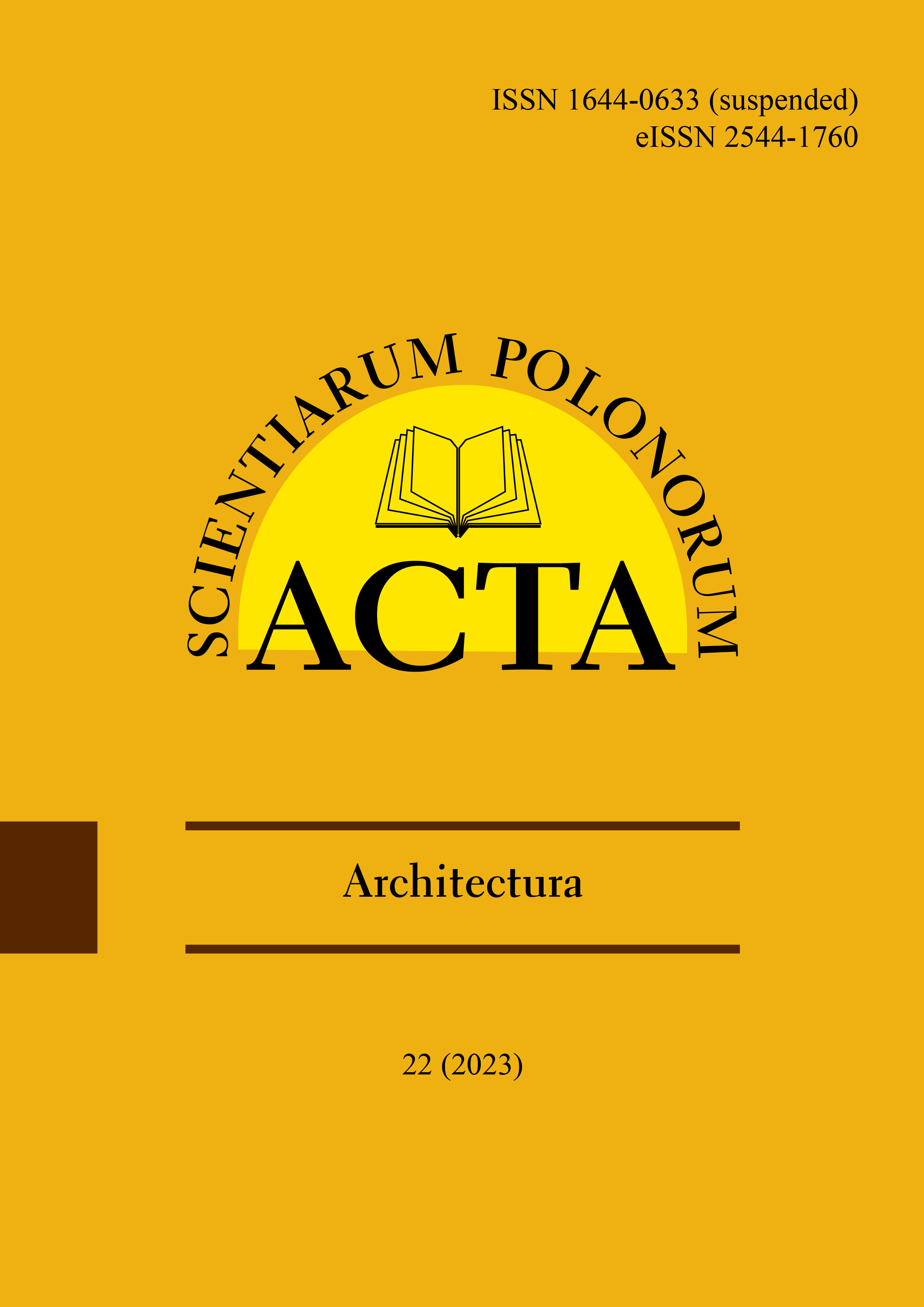Main Article Content
In the 21st century, the most advanced digital methods have allowed structure design, analysis and multidirectional optimisation based on multiple parameters. Mathematical algorithms based on proportionality requirements enable the software to create an individual solution for the specified boundary conditions. This is particularly interesting from the point of view of prefabrication and material engineering, which is now more often characterised by the idea of post-Fordism, where the desire for unification does not exclude the creative search for individual solutions. The research presented in this paper attempts to answer how parametric designing conducted on bar trusses can be implemented into the optimisation of structural elements. The methodology employed in the study involved using of parametric design tools to create a symmetrical truss model, assess its advantages and challenges, and consider load cases. The information provided in the conclusion highlights the evolution of parametric design – which has not only revolutionised architecture and construction by inspiring unconventional forms, but has also facilitated the optimisation of design processes, offered new design possibilities and enabled effective control over various modelling aspects, confirming its invaluable role in both architecture and construction.
Article Details
Alvarado, R. G., Lyon, A. & Cendoya, P. (2015, July). Parametric Development of Variable Roof Structures with Central Supports (Tulips). Nexus Network Journal, 15 (2). https://doi.org/10.1007/s00004-013-0153-9 (Crossref)
Aranburu, A., Camba, J. D., Justel, D. & Contero, M. (2023). An Improved Explicit Reference Modeling Methodology for Parametric Design. Computer-Aided Design, 161. https://doi.org/10.1016/j.cad.2023.103541 (Crossref)
Bialozor, R. & Olszowski, M., Górski, M. (2017, December). Parametric modelling as a shift of decision-making process in structural engineering. In ICEUBI2017 – International Congress on Engineering 2017, 5-7 December 2017 – University of Beira Interior – Covilhã, Portugal.
Caetano, I., Santos, L. & Leitão, A. (2020). Computational design in architecture: Defining parametric, generative, and algorithmic design. Frontiers of Architectural Research, 9 (2), 287–300. https://doi.org/10.1016/j.foar.2019.12.008 (Crossref)
Dixit, S., Stefańska, A. & Musiuk, A. (2021). Architectural form finding in arboreal supporting structure optimisation. Ain Shams Engineering Journal, 12 (2), 2321–2329. https://doi.org/10.1016/j.asej.2020.08.022 (Crossref)
Januszkiewicz, K. & Banachowicz, M. (2017). Nonlinear Shaping Architecture Designed with Using Evolutionary Structural Optimisation Tools. IOP Conference Series: Materials Science and Engineering, 245 (8). https://doi.org/10.1088/1757-899x/245/8/082042 (Crossref)
Khoshamadi, N., Banihashemi, S., Poshdar, M., Abbasianjahromi, H., Tabadkani, A. & Hajirasouli, A. (2023). Parametric and generative mechanisms for infrastructure projects. Automation in Construction, 154. https://doi.org/10.1016/j.autcon.2023.104968 (Crossref)
Kurcjusz, M., Stefańska, A., Dixit, S. & Starzyk, A. (2022). The interdisciplinary designing in form, function, and structure coherency. Acta Scientiarum Polonorum. Architectura, 3 (21), 3–13. (Crossref)
Lehmann, T. H. (2023). Using algorithmic thinking to design algorithms: The case of critical path analysis. The Journal of Mathematical Behavior, 71. https://doi.org/10.1016/j.jmathb.2023.101079 (Crossref)
Markert, R. & Alves, G. (2016). Between Designer and Design: Parametric Design and Prototyping Considerations on Gaudí’s Sagrada Familia. Period. Periodica Polytechnica Architecture, 47 (2), 89–93. https://doi.org/10.3311/PPar.10335 (Crossref)
Serrano Gómez, J., Coll, J., Melero, J. C. & Burry, M. C. (2022). The Need to Step Beyond Conventional Architectural Software. In Proceedings of 11th International Conference Proceedings of the Arab Society for Computer Aided Architectural Design in Europe, 1, 5–25 [update]. https://doi.org/10.52842/conf.ecaade.1993.x.v0u (Crossref)
Stefańska, A. & Rokicki, W. (2022). Architectural Design Optimisation in Reticulated Free-Form Canopies. Buildings, 12 (8). https://doi.org/10.3390/buildings12081068 (Crossref)
Suyoto, W., Indraprastha, A. & Purbo, H. W. (2015). Parametric Approach as a Tool for Decision-making in Planning and Design Process. Case study: Office Tower in Kebayoran Lama. Procedia – Social and Behavioral Sciences, 184, 328–337. http://dx.doi.org/10.1016/j.sbspro.2015.05.098. (Crossref)
Yildirim, E. (2022, October). Topology Optimization in Architecture Practices. Dokuz Eylül University, Faculty of Architecture(October). Retrieved from: https://www.researchgate.net/profile/Erdem-Yildirim-4/public [accessed: 08.09.2023].
Zwierzycki, M. (2013). Ewolucyjne narzędzia cyfrowe w formowaniu struktur przestrzennych. Archivolta, 2 (49), 54–61.
Downloads
- Maja Sutkowska, Anna Stefańska, Magdalena Daria Vaverkova, Yasuhiro Matsui, Fostering sustainable urban development: integrating school areas to support the city’s green-blue infrastructure , Acta Scientiarum Polonorum. Architectura: Vol. 23 (2024)
- Małgorzata Kurcjusz, Karolina Krysińska, Michał Kosakiewicz, Maurycy Naliwajko, Zofia Jabłońska, Karolina Radecka, Ewa Grzegorzewska, Michał Sieczych, Eliza Ferenc-Pupek, Anna Stefańska, Integrating building information modelling (BIM) into construction: innovations, challenges, and global perspectives , Acta Scientiarum Polonorum. Architectura: Vol. 23 (2024)
- Małgorzata Kurcjusz, Tomasz Sokół, Agnieszka Chudzińska, Sizing optimisation of steel truss based on algorithms , Acta Scientiarum Polonorum. Architectura: Vol. 22 (2023)
- Peter Niemczak, Anna Stefańska, Why do Chicago buildings not retrofit? , Acta Scientiarum Polonorum. Architectura: Vol. 22 (2023)
- Anna Stefańska, Katarzyna Walasek, Małgorzata Kurcjusz, Barbara Warzecha, Joanna Koszewska, Piotr Niemczak, Contemporary design of sustainable campus spaces: A case study of the extension of the Water Centre at the Warsaw University of Life Sciences – SGGW , Acta Scientiarum Polonorum. Architectura: Vol. 24 (2025)
- Agata Muchla, Anna Stefańska, Exploring the benefits of open BIM standards for enhanced interoperability and efficiency in architecture, engineering, and construction projects , Acta Scientiarum Polonorum. Architectura: Vol. 24 (2025)

This work is licensed under a Creative Commons Attribution-NonCommercial 4.0 International License.

